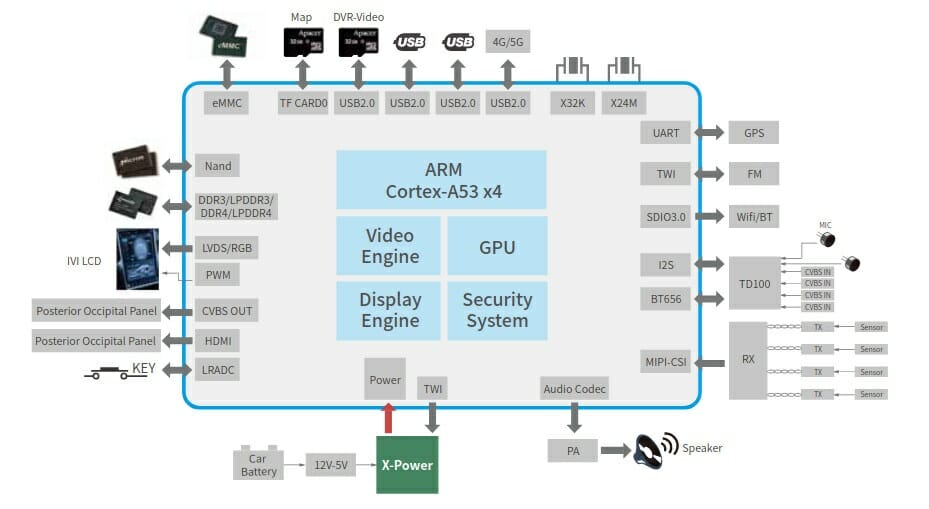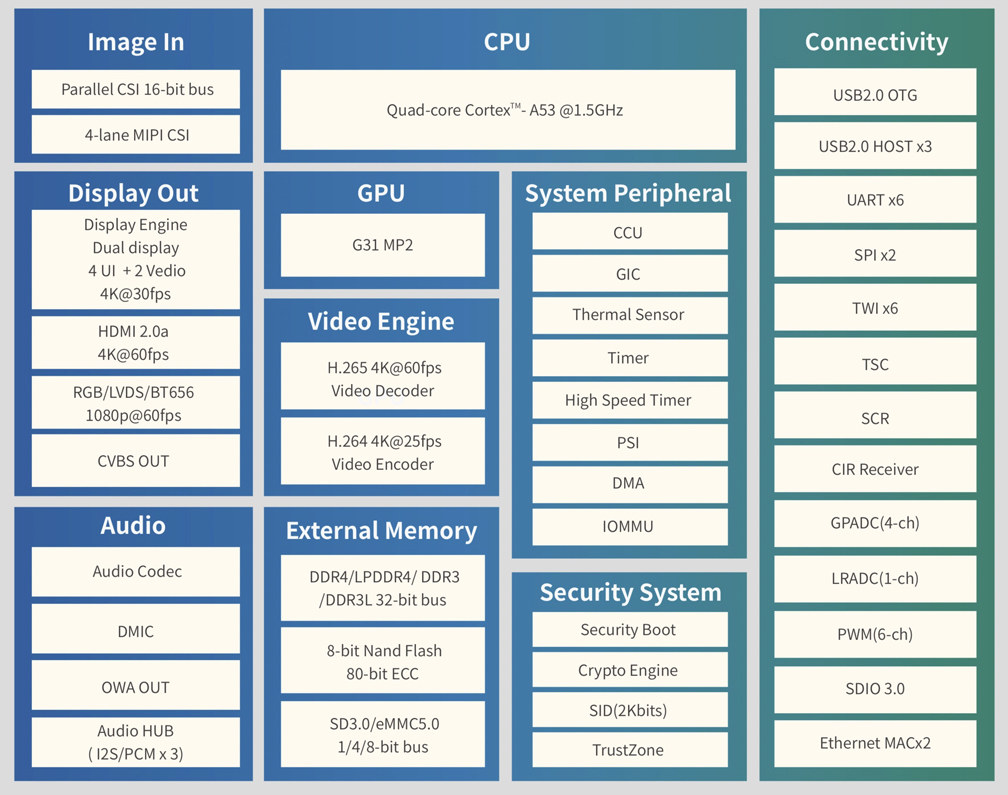Allwinner T-series processors are designed for transportation applications such as automotive infotainment systems, smart rear-view mirrors, and navigation systems.
The Zhuhai-based company has now added a new T-series processor to its website with Allwinner T5 processor featuring four Cortex-A53 cores and a Mali-G31 MP2 GPU that’s a nice upgrade to the Mali-400 MP2/4 GPUs used in their other automotive processors.
Allwinner T5 specifications:
- CPU – Quad-core Arm Cortex-A53@1.5GHz
- GPU – Arm Mali G31 MP2 with support for OpenGL ES 3.2/2.0/1.0, Vulkan 1.1, OpenCL 2.0
- Memory I/F – 32-bit DDR4/DDR3/DDR3L/LPDDR3/LPDDR4 interface up to 4GB
- Storage I/F
- SD3.0/eMMC5.0 interface
- 8-bit Nand flash interface with maximum 80-bit/1KB ECC
- Video Engine
- Video decoder
- H.265 MP decoder up to 4K @ 60fps
- H.264 BL/MP/HP decoder up to 4K @ 30fps
- VP9 decoder up to 4K @ 60fps
- AVS2 decoder up to 4K @ 60fps
- Multi-format 1080p60 video playback including VP8, MPEG1/2 SP/MP, MPEG4 SP/ASP, AVS+/AVS JIZHUN, VC1 SP/MP
- Video encoder -H.264 encoder up to 4K @ 25fps, MJPEG encoder up to 4K @ 15fps, JPEG encoder up to 8K x 8K resolution
- Video decoder
- Video Output
- HDMI 2.0a up to 4K @ 60fps
- TV CVBS output (PAL/NTSC)
- Dual-channel LVDS interface up to 1080p @ 60fps
- RGB interface with DE/SYNC mode up to 1080p@60fps
- Video Input
- 1x 8-/10-/12-/16-bit digital camera interface up to 148.5MHz pixel clock
- BT656, BT1120 video input for multichannel YUV
- 4-lane MIPI CSI up to 1Gbps per lane compliant with MIPI-CSI2 V1.00 and MIPI DPHY V1.00
- Maximum video capture resolution of 8M @ 30fps or 4x 1080p @ 25fps for MIPI CSI
- Supported formats – YUV422, YUV420, RAW-8, RAW-10, RAW-12
- Audio
- 2x DAC channels and 4x ADC channels
- 1x audio output interface (differential LINEOUTP/N or single-end LINEOUTL/LINEOUTR)
- Audio HUB with internal mixing function
- 3x I2S/PCM interfaces (I2S0 for extended audio codec, I2S2 for BT, I2S3 for digital power amplifier)
- Supports Left-justified, Right-justified, Standard I2S mode, PCM mode, and TDM mode
- I2S mode supports up to 8 channels and 32-bit/192kbit sample rate
- I2S and TDM modes support a maximum of 16 channels and 32-bit/96kbit sample rate
- 1x 16-/20-/24-bit OWA (One Wire Audio) IOUT interface
- Support for up to 8x digital PDM microphones
- Ethernet – 2x Ethernet MAC (one 10/100 Mbps Ethernet port with RMII interface, one 10/100/1000 Mbps Ethernet port with RGMII and RMII interfaces)
- USB – 3x USB2.0 Host, 1x USB2.0 OTG
- Other Peripherals
- SDIO 3.0, TSC, SCR, CIR Receiver
- 6x TWI, 2x SPI, 6x UART
- 6-ch PWM, 4-ch GPADC, 1-ch LRADC
- Security Engine
- Full Disk Encryption
- AES, DES, 3DES, and XTS encryption algorithms
- MD5, SHA, and HMAC hash
- RSA, ECC signature and verification algorithms
- 160-bit hardware pseudo-random number generator (PRNG) with 175-bit seed
- 256-bit hardware true random number generator (TRNG)
- 2K-bit EFUSE for chip ID and security application
- PMIC – Companion Allwinner Power Management IC
- Package – TFBGA 421 balls; 15 mm x 15 mm size,0.65 mm ball pitch,0.35 mm ball size
- Process – 28nm HPC
- Temperature Range – -40 to 85
- Automotive AEC-Q100 qualification

Allwinner T5 shares many of the same features and specifications as Allwinner H616 TV box SoC, but it’s a more advanced and larger chip that adds support for LVDS and RGB displays, multiple camera support, wide operating temperature range, and AEC-Q100 qualification. It does without some of the TV box-specific features such as high dynamic range.
Allwinner T5 should be found in IVI (In-Vehicle Infotainment), digital clusters, HD AVM (Automatic Vehicle Monitoring) systems, HUD (Heap Up Display), and other intelligent cockpit products running either Android 10 or Linux as the company offers BSPs for both operating systems.
I could not find products powered by the new processor yet, except for a demo of an Android 10 car radio connected to two cameras. More details may be found on the processor’s product page.
Thanks to Théo for the tip.

Jean-Luc started CNX Software in 2010 as a part-time endeavor, before quitting his job as a software engineering manager, and starting to write daily news, and reviews full time later in 2011.
Support CNX Software! Donate via cryptocurrencies, become a Patron on Patreon, or purchase goods on Amazon or Aliexpress





